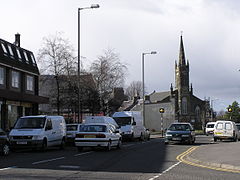Bannockburn
Bannockburn
|
|
|---|---|
 The centre of Bannockburn |
|
| Bannockburn shown within the Stirling council area | |
| Population | 7,352 |
| OS grid reference | NS811902 |
| • Edinburgh | 35 mi (56 km) ESE |
| • London | 410 mi (660 km) SSE |
| Council area | |
| Lieutenancy area | |
| Country | Scotland |
| Sovereign state | United Kingdom |
| Post town | STIRLING |
| Postcode district | FK7 |
| Dialling code | 01786 |
| Police | Scottish |
| Fire | Scottish |
| Ambulance | Scottish |
| EU Parliament | Scotland |
| UK Parliament | |
| Scottish Parliament | |
| Website | www.bannockburn.co.uk |
Bannockburn (Scottish Gaelic Allt a' Bhonnaich) is a town immediately south of the city of Stirling in Scotland. It is named after the Bannock Burn, a burn (small stream) running through the town before flowing into the River Forth.
Land in the vicinity of Bannockburn town, probably between the Pelstream and Bannock burns (hence Bannokburn), was the site of the Battle of Bannockburn fought in 1314—one of the pivotal battles of the 13th/14th century Wars of Independence between the kingdoms of Scotland and England. A large monument and visitor centre is located near the site of the battle. The dignity of the barony of Bannockburn is currently held by Hope Vere Anderson a descendent of the Sandilands and Vere families of Sandilands and Lesmahagow, Lanarkshire who were the original Barons of Bannockburn in the 14th. century.
In the late 18th and early 19th centuries the Wilson family of Bannockburn designed and wove tartans for the British Army. Many of the so-called Clan tartans were created by the Wilsons in response to the needs of the Clan chiefs who, without their own authentic tartans, approached the Wilsons for suitable patterns. The visit of King George IV to Edinburgh in 1822, and his insistence that the Clan chiefs attend his banquets and levees in their Clan tartans, prompted this reaction. The Wilson family ceased business in 1924.
A circular-arch stone bridge, built by engineer Thomas Telford, spans the burn downstream of the battle site. Growth of both Stirling and Bannockburn during the 19th and 20th centuries means that the two now form a contiguous conurbation, and Bannockburn was latterly incorporated into the city (then royal burgh) of Stirling. Bannockburn had a population of 7352 at the time of the 2001 census.
...
Wikipedia

